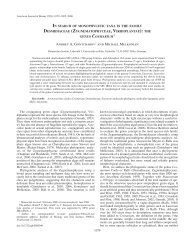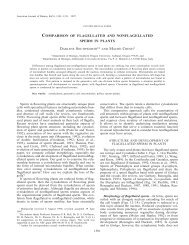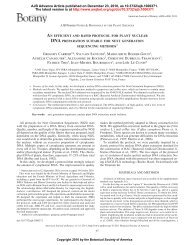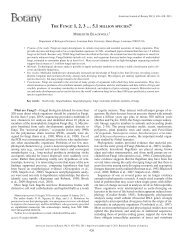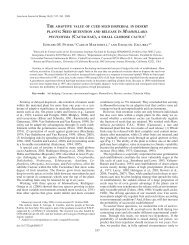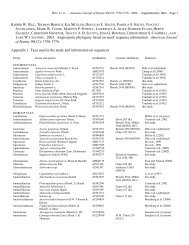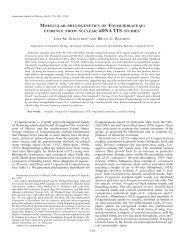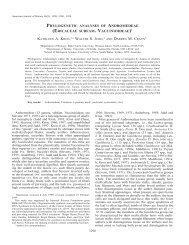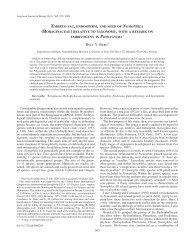genetic variation and structure in the expanding moss pogonatum ...
genetic variation and structure in the expanding moss pogonatum ...
genetic variation and structure in the expanding moss pogonatum ...
Create successful ePaper yourself
Turn your PDF publications into a flip-book with our unique Google optimized e-Paper software.
October 2005] HASSEL ET AL.—GENETIC DIVERSITY OF AN EXPANDING MOSS<br />
1685<br />
<strong>moss</strong> species, P. dentatum, <strong>in</strong> its orig<strong>in</strong>al range <strong>and</strong> <strong>in</strong> a recently<br />
colonized area <strong>in</strong> nor<strong>the</strong>rn Sweden us<strong>in</strong>g ISSR (<strong>in</strong>tersimple<br />
sequence repeats) as molecular markers. Compar<strong>in</strong>g <strong>the</strong><br />
<strong>genetic</strong> composition <strong>in</strong> <strong>the</strong> two areas seeks to describe <strong>the</strong><br />
pattern of molecular <strong>genetic</strong> <strong>variation</strong>, <strong>and</strong> to obta<strong>in</strong> knowledge<br />
about <strong>the</strong> processes shap<strong>in</strong>g <strong>the</strong>se patterns.<br />
Two alternative hypo<strong>the</strong>ses ma<strong>in</strong>ly differ<strong>in</strong>g <strong>in</strong> <strong>the</strong> underly<strong>in</strong>g<br />
dispersal mechanisms can be formulated. Hypo<strong>the</strong>sis 1:<br />
Expansion of P. dentatum is a result of easily dispersed <strong>and</strong><br />
sexually produced spores. Prediction 1.1: Effective spore dispersal<br />
<strong>and</strong> establishment will result <strong>in</strong> high haplotype diversity<br />
<strong>and</strong> spore establishment is found to be common <strong>in</strong> <strong>the</strong> lowl<strong>and</strong>s<br />
while rare <strong>in</strong> <strong>the</strong> mounta<strong>in</strong>s (Hassel <strong>and</strong> Söderström,<br />
2003). Prediction 1.2: Little <strong>genetic</strong> differentiation will take<br />
place among populations, due to effective dispersal. Hypo<strong>the</strong>sis<br />
2: The expansion of P. dentatum is a result of occasional<br />
dispersal of vegetative fragments by, e.g., cars or o<strong>the</strong>r human<br />
activities. Prediction 2.1: Restricted dispersal will keep haplotype<br />
diversity low for a long time after <strong>in</strong>itial establishment.<br />
Prediction 2.2: Genetic differentiation will take place among<br />
populations due to low gene flow (restricted dispersal). In addition,<br />
low levels of <strong>genetic</strong> <strong>variation</strong> are expected with<strong>in</strong> populations<br />
due to local recruitment by locally dispersed asexual<br />
fragments.<br />
If sexual reproduced spores are <strong>the</strong> ma<strong>in</strong> agent of dispersal,<br />
no l<strong>in</strong>kage among loci is expected. In contrast, high l<strong>in</strong>kage<br />
(l<strong>in</strong>kage disequilibrium) is expected if asexual reproduction by<br />
fragments is dom<strong>in</strong>at<strong>in</strong>g. For both scenarios of dispersal, we<br />
predict that newly established populations would experience a<br />
bottleneck with loss of rare alleles.<br />
MATERIALS AND METHODS<br />
Study species—Pogonatum dentatum has acrocarpous growth <strong>and</strong> is frequently<br />
recorded with sporophytes <strong>in</strong> both mounta<strong>in</strong> <strong>and</strong> lowl<strong>and</strong> areas.<br />
Spores are small (17–22 m diameter), produced <strong>in</strong> large quantities (200 000–<br />
450 000 per capsule), <strong>and</strong> are potentially important <strong>in</strong> long-distance dispersal<br />
(Hassel <strong>and</strong> Söderström, 2003). It lacks specialized asexual diaspores, but<br />
fragmentation is potentially important for local dispersal. Asexual reproduction<br />
by fragmentation may take place from a s<strong>in</strong>gle leaf or larger fragments<br />
like part of a stem (Hassel <strong>and</strong> Söderström, 2003). Vegetative reproduction<br />
by rhizoid wicks such as known for Polytrichum species (Wiggelsworth,<br />
1947) has been searched for <strong>in</strong> P. dentatum, but not found (K. Hassel, unpublished).<br />
Establishment from spores <strong>and</strong> fragments is common <strong>in</strong> <strong>the</strong> lowl<strong>and</strong><br />
area, but seems to be less frequent <strong>in</strong> <strong>the</strong> mounta<strong>in</strong> area (Hassel <strong>and</strong><br />
Söderström, 1999, 2003). In <strong>the</strong> study area, P. dentatum typically occurs on<br />
disturbed m<strong>in</strong>eral soil. In <strong>the</strong> mounta<strong>in</strong>s, <strong>the</strong> ma<strong>in</strong> disturbance factors are frost<br />
heav<strong>in</strong>g <strong>and</strong> w<strong>in</strong>d, whereas <strong>in</strong> <strong>the</strong> lowl<strong>and</strong>s road construction <strong>and</strong> ma<strong>in</strong>tenance<br />
are <strong>the</strong> most common causes of soil disturbances that lead to creation of new<br />
habitats.<br />
Study area—Populations were sampled from two areas <strong>in</strong> nor<strong>the</strong>rn Sweden<br />
(Fig. 1) <strong>in</strong> August 2001. The mounta<strong>in</strong> area is <strong>in</strong> <strong>the</strong> alp<strong>in</strong>e region at Stekenjokk<br />
(6505N, 1430E; 800 m a.s.l.) on a mounta<strong>in</strong> heath above <strong>the</strong> tree<br />
limit. The lowl<strong>and</strong> area is <strong>in</strong> <strong>the</strong> boreal region at Junsele (6345N, 1715E,<br />
altitude 300 m a.s.l.) <strong>in</strong> spruce forest. The mounta<strong>in</strong> <strong>and</strong> lowl<strong>and</strong> areas are<br />
part of <strong>the</strong> same valley <strong>and</strong> river system, Ångermanälven. If range expansion<br />
takes place by stepwise dispersal, this would be a natural colonization route,<br />
because expansion of forestry activity followed <strong>the</strong> valley system toward <strong>the</strong><br />
mounta<strong>in</strong>s.<br />
Fig. 1. Map of Sc<strong>and</strong><strong>in</strong>avia <strong>in</strong>dicat<strong>in</strong>g <strong>the</strong> Swedish study sites <strong>in</strong> <strong>the</strong> lowl<strong>and</strong><br />
area (L) <strong>and</strong> mounta<strong>in</strong> area (M). The small maps <strong>in</strong>dicate <strong>the</strong> distance<br />
between <strong>the</strong> studied populations (1–6, 10, 12) with<strong>in</strong> each area.<br />
Sampl<strong>in</strong>g <strong>and</strong> DNA analysis—Four populations of P. dentatum were sampled<br />
from both <strong>the</strong> mounta<strong>in</strong> <strong>and</strong> lowl<strong>and</strong> areas (Table 1). A population was<br />
delimited as a group of patches of P. dentatum shoots occurr<strong>in</strong>g at a restricted<br />
site. In each of <strong>the</strong> eight populations, a transect was placed from <strong>the</strong> population<br />
edge towards its centre. Along each transect, five patches (cluster of<br />
shoots that consist of one or more <strong>in</strong>dividuals/genets) separated by 2–2.5 m<br />
were sampled. From each patch, five shoots (gametophores/ramets) were sampled<br />
from a quadrat (10 10 cm), one shoot from each corner <strong>and</strong> one from<br />
<strong>the</strong> center. Shoots were put <strong>in</strong> paper bags, air dried, <strong>and</strong> stored at 4C until<br />
analyzed.<br />
ISSR markers where chosen because <strong>the</strong>y are easy <strong>and</strong> <strong>in</strong>expensive to apply<br />
<strong>and</strong> have been successfully used <strong>in</strong> population studies of vascular plants (e.g.,<br />
Wolfe et al., 1998; Yannic et al., 2004) <strong>and</strong> bryophytes (e.g., Korpela<strong>in</strong>en <strong>and</strong><br />
Virtanen, 2003; V<strong>and</strong>erpoorten et al., 2003; Gunnarsson et al., 2005). The<br />
shoots were washed <strong>in</strong> sterile water before DNA extraction. DNA extraction,<br />
PCR setup, <strong>and</strong> visualization of PCR products followed Hassel <strong>and</strong> Gunnarsson<br />
(2003). The <strong>in</strong>tersimple sequence repeat (ISSR) primers, anneal<strong>in</strong>g temperature,<br />
<strong>and</strong> <strong>the</strong> number of scoreable fragments per primer are shown <strong>in</strong><br />
Table 2. B<strong>and</strong>s were scored manually, <strong>and</strong> a table of presence/absence of<br />
ISSR fragments was compiled.<br />
Data analysis—Assessment of <strong>genetic</strong> <strong>variation</strong> from sampl<strong>in</strong>g of ramets<br />
<strong>in</strong> clonal organisms is problematic. Estimat<strong>in</strong>g allele frequencies at <strong>the</strong> ramet<br />
level runs <strong>the</strong> risk of pseudoreplication because some haplotypes may be<br />
represented more than once <strong>in</strong> <strong>the</strong> population, whereas <strong>in</strong> genet-level calculations<br />
different genets with identical multilocus haplotypes cannot be dist<strong>in</strong>-



